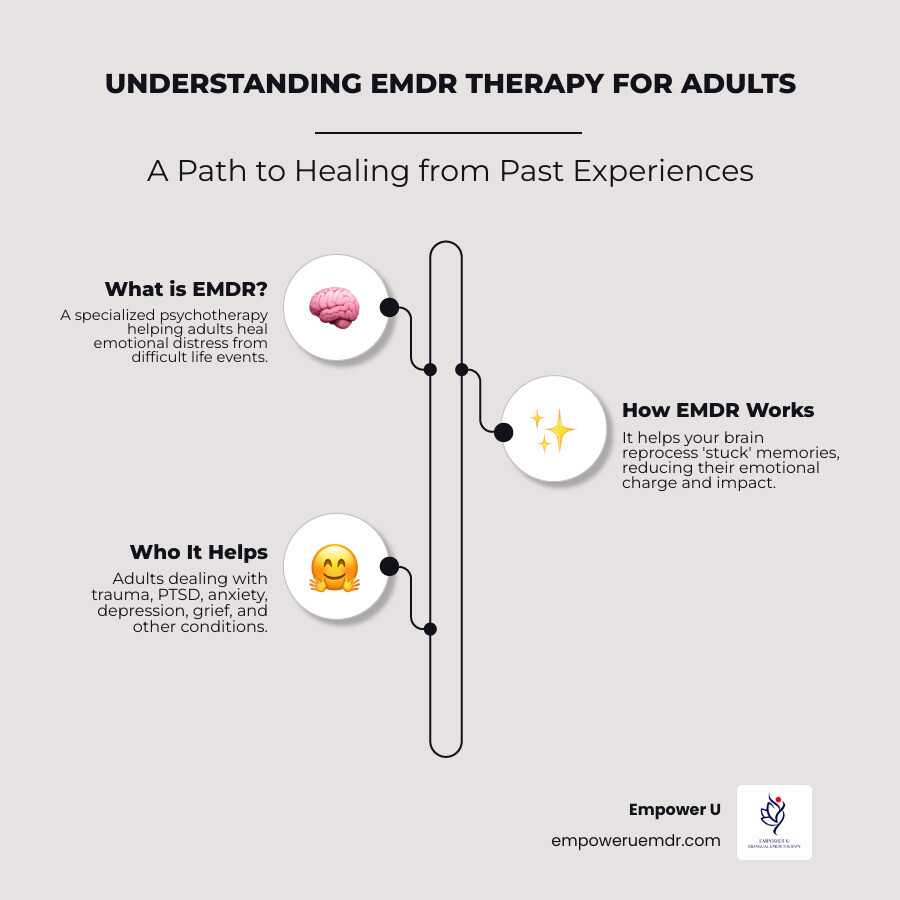EMDR Therapy for Adults: Healing Trauma While Honoring Your Cultural Identity

Finding Peace Between Two Worlds Through Eye Movement Desensitization and Reprocessing
As an adult child of immigrants or someone who came to this country at a young age, you may carry traumatic memories and emotional distress that traditional talk therapy hasn't quite reached. The constant pull between honoring your family's values and navigating mainstream American culture can leave you feeling exhausted, anxious, and questioning who you really are. If you're struggling with persistent self-doubt, guilt, or PTSD symptoms from unprocessed traumatic experiences, EMDR therapy offers a path to healing that honors both your cultural identity and your individual journey.
I'm Cristina Deneve, a Licensed Marriage and Family Therapist who specializes in EMDR therapy for adults navigating bicultural identities. As someone who switched from engineering to therapy as part of my own journey of reconnecting with myself, I deeply understand what it means to question your place in the world. In my EMDR practice at Empower U, I combine the power of eye movement desensitization and reprocessing with cultural sensitivity to help clients heal traumatic memories while honoring their complex identities.
Understanding EMDR Therapy: A Powerful Approach to Mental Health
EMDR therapy (Eye Movement Desensitization and Reprocessing) is a structured therapy and evidence-based form of trauma-focused psychotherapy that helps your brain process traumatic experiences that have gotten "stuck." The World Health Organization and American Psychiatric Association both recognize EMDR treatment as an effective treatment for post traumatic stress disorder and other trauma-related conditions.
Think of it this way: your mind naturally processes most experiences through your natural healing process, filing them away as memories that don't continue to cause emotional distress. But sometimes, particularly painful events or disturbing events don't get processed completely. These trauma memories remain frozen with all their original emotions, physical sensations, and negative beliefs intact, often manifesting as PTSD symptoms or other mental health challenges.
EMDR therapy focuses directly on helping your brain complete this natural healing process through bilateral stimulation—typically eye movements, though other forms of movement desensitization and reprocessing techniques can be used. Multiple randomized clinical trials and ongoing research have demonstrated EMDR's effectiveness, with the Veterans Affairs and American Psychiatric Association endorsing it as a primary treatment for treating PTSD.
How EMDR Works: The Science Behind Eye Movement Desensitization
EMDR therapy consists of eight structured phases that work together to process traumatic memories and reduce their emotional impact. The core of EMDR treatment involves bilateral stimulation—gentle, rhythmic movements that activate both sides of your brain, similar to what happens during rapid eye movement (REM) sleep when your mind processes daily experiences.
During EMDR sessions, this bilateral stimulation might involve:
- Eye movements: Following my finger or a light bar as it moves side to side
- Gentle tapping: Alternating tapping on your hands, knees, or using handheld devices
- Auditory tones: Listening to alternating sounds through headphones
This process, combined with simultaneously experiencing bilateral stimulation while briefly bringing the targeted memory to mind, helps your brain reprocess traumatic experiences. The memory loses its emotional charge, negative beliefs transform into positive beliefs, and limiting thoughts can shift into healthier positive cognitions.

Why EMDR Therapy Is Particularly Effective for Bicultural Individuals
Growing up between cultures creates unique psychological challenges that EMDR therapy addresses exceptionally well. The constant code-switching, pressure to make your parents' sacrifices "worth it," and exhaustion of never feeling fully accepted in either world can create deep patterns of self-criticism, negative emotions, and anxiety—often developing into trauma stress and other distressing life experiences.
In my work with immigrants from collectivistic cultures—including Latino, Asian, Middle Eastern, North African, Russian, and other backgrounds—I've seen how EMDR treatment can help process:
Identity-Related Traumatic Memories: Those moments when you felt ashamed of your culture or guilty for embracing American values. EMDR therapy can help resolve these internal conflicts through targeted memory processing.
Intergenerational Trauma: The unspoken pain your parents carried, including experiences of emotional abuse or adverse life experiences, that somehow became yours to bear. Eye movement desensitization and reprocessing helps separate your story from inherited emotional burdens.
Perfectionism and Negative Beliefs: The relentless inner voice saying you're never good enough. EMDR sessions can transform these limiting beliefs into empowering positive beliefs about your worth and belonging.
Physical Symptoms Stemming from Trauma: Chronic pain, tension, or other body sensations often connected to unprocessed traumatic experiences. The body scan component of EMDR practice addresses these physical manifestations.
My Culturally Responsive EMDR Practice
When you work with me, you're receiving EMDR treatment from someone who truly understands your bicultural experience. Spanish is my first language, and I offer bilingual therapy for those who feel more comfortable expressing themselves in Spanish or switching between languages during EMDR sessions.
My approach integrates EMDR therapy with other effective treatments including Narrative Therapy, Cognitive Behavioral Therapy (CBT), Dialectical Behavior Therapy (DBT), and Internal Family Systems (IFS). This combination helps you not only process trauma memories but also build essential coping skills for daily life and integrate different parts of yourself.
Unlike other therapies that may require years of talk therapy, EMDR often produces significant results in fewer sessions, making it an efficient path to healing traumatic memories and reducing PTSD symptoms.
The Eight Phases of EMDR Therapy: A Comprehensive Approach
EMDR therapy consists of eight distinct phases that I customize to your unique needs and cultural context. This structured therapy approach ensures thorough processing of traumatic experiences while building your capacity for emotional regulation.
Phase 1: History-Taking and Treatment Planning
We begin by exploring your story within the context of your cultural background and family dynamics. I gather patient history to understand not just what happened, but how traumatic events impacted your sense of self. Together, we identify specific trauma memories or other distressing life experiences contributing to your current struggles, creating a roadmap for our EMDR treatment.
Phase 2: Preparation and Resource Building
Before processing any disturbing events, I ensure you feel safe and equipped with coping skills. I teach you practical techniques for managing emotional distress and help you create mental resources. For bicultural clients, I often incorporate culturally meaningful imagery that feels authentic to your experience, building a foundation for successful EMDR sessions.
Phase 3: Assessment of Target Memory
We select a specific traumatic memory to work on and identify its key components: the most disturbing image, the negative beliefs it created (like "I don't belong anywhere"), and the accompanying negative emotions and body sensations. We also identify positive beliefs you'd prefer to have (like "I belong exactly as I am") and establish baseline measurements for the targeted memory.
Phase 4: Desensitization Through Eye Movements
This is where the core processing happens. While you briefly hold the target memory in mind, I guide you through sets of eye movements or other bilateral stimulation. You simply notice whatever comes up—additional memories, body sensations, negative feelings, or insights—without judgment. Between sets, I check in as client reports emerge. Your brain naturally makes new connections until the traumatic memory's emotional charge significantly decreases.
Phase 5: Installation of Positive Beliefs
Once the memory no longer causes emotional distress, we strengthen the positive belief or positive cognition. We pair this empowering statement with the original memory and use more bilateral stimulation until this new positive belief feels authentically true, replacing old negative beliefs.
Phase 6: Body Scan for Physical Sensations
Since trauma often manifests as physical symptoms, you'll mentally scan your body for any remaining tension or body sensations related to the memory. If any discomfort emerges, we'll process it through additional eye movements until your body feels as calm as your mind.
Phase 7: Closure and Stabilization
Every EMDR session ends with ensuring you feel grounded and stable. We use the coping skills from Phase 2 to help you feel centered before returning to daily life, ensuring you leave each session feeling resourced and secure.
Phase 8: Re-evaluation and Progress Assessment
Each new session begins as the therapist evaluates your progress with previously processed memories. We ensure positive changes are holding and address any newly emerged trauma memories or insights, maintaining the comprehensive nature of EMDR treatment.

Conditions Effectively Treated with EMDR Therapy
EMDR therapy has been extensively researched through randomized controlled trials and proven effective for numerous mental health conditions beyond post traumatic stress disorder:
Post Traumatic Stress Disorder (PTSD): EMDR is recognized as a primary treatment for treating PTSD, effectively reducing PTSD symptoms including flashbacks, nightmares, and hypervigilance through processing of traumatic memories.
Anxiety and Panic Disorders: By addressing underlying traumatic experiences that fuel generalized anxiety and panic attacks, EMDR treatment often provides lasting relief where other therapies may fall short.
Depression and Negative Emotions: EMDR therapy can process adverse life experiences that contribute to hopelessness and persistent negative emotions, often achieving results in fewer sessions than traditional approaches.
Complex Trauma from Emotional Abuse: For those who experienced ongoing emotional abuse or neglect, EMDR's systematic approach helps process multiple trauma memories while building emotional regulation skills.
Grief and Complicated Loss: EMDR helps process traumatic aspects of loss, allowing you to maintain loving memories while reducing overwhelming emotional distress.
Cultural Identity Conflicts: Unique to my EMDR practice, we address the specific traumatic experiences related to cultural displacement, discrimination, and identity confusion common among immigrants.
The Research Behind EMDR: Evidence-Based Mental Health Treatment
The effectiveness of eye movement desensitization and reprocessing is supported by extensive ongoing research and multiple randomized clinical trials. Major organizations including the World Health Organization, American Psychiatric Association, and Veterans Affairs all recommend EMDR as an effective treatment for trauma-related conditions.
Research consistently shows that EMDR often works faster than other therapies, with many clients experiencing significant improvement in fewer sessions. The bilateral stimulation component of EMDR activates the brain's natural healing process, similar to what occurs during rapid eye movement sleep when the mind processes and integrates daily experiences.
Studies demonstrate that EMDR therapy:
- Effectively reduces PTSD symptoms and trauma-related distress
- Often produces lasting results faster than traditional talk therapy
- Successfully treats both single-incident and complex traumatic experiences
- Helps clients develop healthier coping skills and emotional regulation
- Addresses both psychological and physical symptoms stemming from trauma

What Makes EMDR Different from Other Therapies
Unlike traditional talk therapy that requires extensive verbal processing of traumatic events, EMDR therapy allows healing to occur through your brain's natural processing abilities. While you'll briefly bring disturbing events to mind, you won't need to narrate every detail of your traumatic experiences.
The combination of bilateral stimulation and targeted memory processing creates a unique therapeutic environment where:
- Traumatic memories lose their emotional intensity without being forgotten
- Negative beliefs naturally transform into positive beliefs
- Physical symptoms and body sensations often resolve as trauma memories are processed
- Clients typically need fewer sessions compared to other therapeutic approaches
- The natural healing process is activated without requiring extensive verbal recounting
This makes EMDR particularly valuable for those who find it difficult to discuss traumatic experiences in detail or who haven't found relief through other forms of therapy.
Frequently Asked Questions About EMDR Treatment
How long does EMDR therapy take? The duration varies based on individual needs and the complexity of traumatic experiences being addressed. Some clients notice significant improvement in just a few EMDR sessions, while those with complex trauma histories may benefit from several months of treatment. Unlike other therapies that may require years, EMDR often produces lasting results in fewer sessions.
Can EMDR be done online? Absolutely. I provide all EMDR sessions through secure online platforms, making this specialized mental health treatment accessible from anywhere in California. The bilateral stimulation adapts beautifully to online formats through visual cues, auditory tones, or guided self-tapping techniques.
Will I have to relive traumatic events? No. While you'll briefly bring traumatic memories to mind, EMDR doesn't require detailed recounting of disturbing events. The eye movements and bilateral stimulation allow your brain to process traumatic experiences without having to verbally relive them.
Is EMDR safe? EMDR is considered a safe, evidence-based treatment when provided by trained EMDR practitioners. The structured therapy approach includes built-in safety measures, and I ensure you have adequate coping skills before processing any traumatic memories.
Taking the First Step Toward Healing
If you're ready to stop feeling trapped by traumatic memories and cultural conflicts, EMDR therapy might be the key to unlocking your healing. In our work together, we'll process the traumatic experiences that have been keeping you stuck while building your capacity to live as your full, authentic self.
Your struggles with anxiety, depression, self-doubt, and the complex emotions that come from navigating between cultures make perfect sense. These aren't signs that you're broken—they're natural responses to challenging experiences that deserve compassionate, culturally responsive treatment.
Through EMDR therapy, we can help you:
- Process traumatic memories that continue to impact your daily life
- Transform negative beliefs into empowering positive beliefs about yourself
- Reduce PTSD symptoms and emotional distress
- Develop effective coping skills for managing cultural pressures
- Heal physical symptoms stemming from unprocessed trauma
- Build confidence in your bicultural identity
- Improve your relationships and emotional well-being
Beginning Your EMDR Journey
Your story matters. Your traumatic experiences deserve acknowledgment and healing. And your path forward—one that honors both your cultural heritage and your individual needs—is not only possible but achievable through evidence-based EMDR treatment.
I invite you to reach out and begin this journey of processing traumatic memories and reclaiming your peace. Whether you prefer to communicate in English or Spanish, I'm here to provide culturally responsive EMDR therapy that addresses your unique experiences as someone navigating multiple cultural identities.
Contact me today to learn more about how EMDR therapy can support your healing journey. Together, we can help you process the past, reduce emotional distress, and create a future where all parts of your identity can coexist peacefully.

